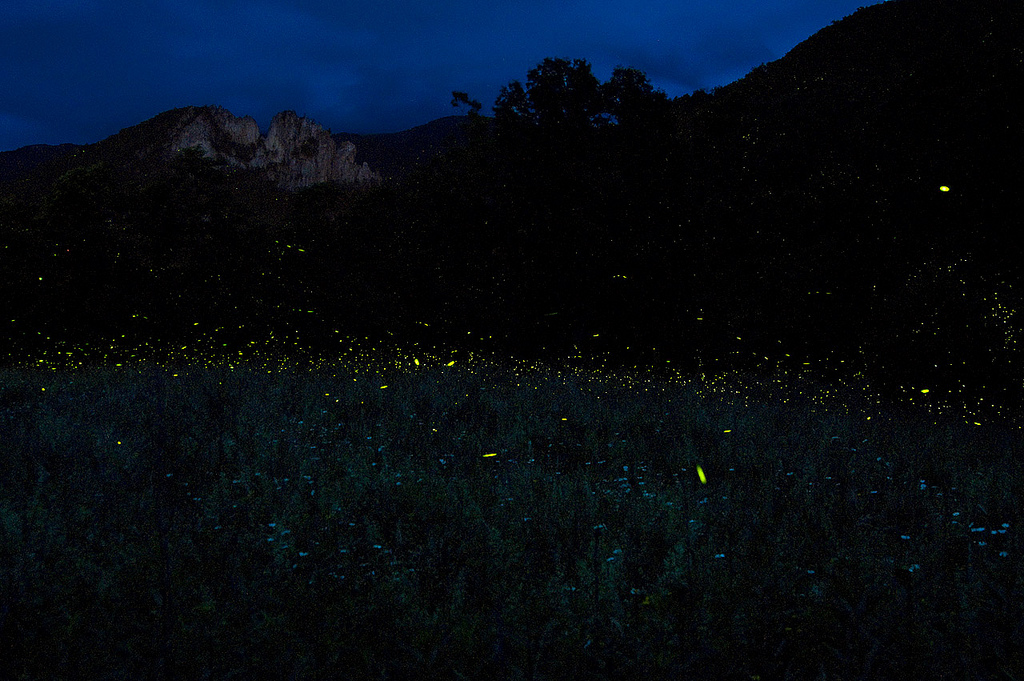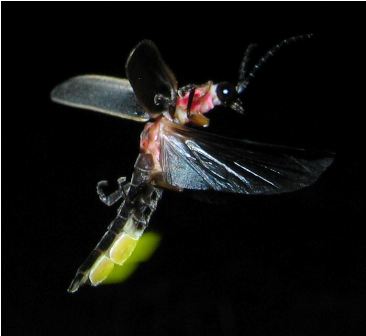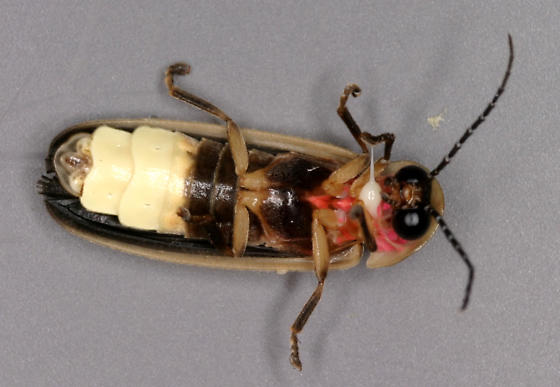
Light it up!

Fireflies have adapted to their
nighttime niche through their use of bioluminescence. Males will
take flight and emit flashes that vary species to species with
respect to color, rate, length, and intensity of light pulse in
order to attract a female.
Organs producing the light are located on the underside of the
posterior abdominal segments; more segments are luminous in the
male and the light is brighter.
Light is produced in a chemical reaction which occurs in the
 presence of oxygen between the compound luciferan and the enzyme
luciferase. There are thousands of specialized
cells in the abdomen of the firefly that lights up (lantern)
called photocytes. The photocytes make the luciferan and
luciferase. Mitochondria surround the photocytes. The nervous
system doesn’t directly control the photocytes. The flash
triggering nerve impulse goes to non-luminescent cells next to
the photocytes. The impulse ends up triggering nitric oxide
production. The nitric oxide is what stimulates the light
production. It turns on the flash by temporarily
stopping the oxygen consumption of the photocyte’s mitochondria.
Oxygen can then diffuse farther into the interior of the
photocyte, where it triggers the light-producing reaction
between luciferan and luciferase. The flash turns off as the
nitric oxide is used up and the mitochondria start to consume
oxygen again. Learn more on nitric oxide and the control of
firefly flashing by Barry A. Trimmer, June R. Aprille, and others by
clicking here.
presence of oxygen between the compound luciferan and the enzyme
luciferase. There are thousands of specialized
cells in the abdomen of the firefly that lights up (lantern)
called photocytes. The photocytes make the luciferan and
luciferase. Mitochondria surround the photocytes. The nervous
system doesn’t directly control the photocytes. The flash
triggering nerve impulse goes to non-luminescent cells next to
the photocytes. The impulse ends up triggering nitric oxide
production. The nitric oxide is what stimulates the light
production. It turns on the flash by temporarily
stopping the oxygen consumption of the photocyte’s mitochondria.
Oxygen can then diffuse farther into the interior of the
photocyte, where it triggers the light-producing reaction
between luciferan and luciferase. The flash turns off as the
nitric oxide is used up and the mitochondria start to consume
oxygen again. Learn more on nitric oxide and the control of
firefly flashing by Barry A. Trimmer, June R. Aprille, and others by
clicking here.
 The light of the firefly is not only used for mating purposes,
but it is also an aposematic signal. According to Paul R.
Mooseman, Jr., Christopher K. Cratsley, and others, “bioluminescence of adult fireflies should indeed be considered
in the context of a warning signal against bats, in addition to
its relatively well-studied role in courtship.” Bats were used in
their study because bats and fireflies are most active at the
same time. Some species of firefly are chemically defended so
the use of their bioluminescence would be a warning to bats,
toads, and other animals. Learn more about their study on
aposematic signals to insectivorous bats by
clicking here.
The light of the firefly is not only used for mating purposes,
but it is also an aposematic signal. According to Paul R.
Mooseman, Jr., Christopher K. Cratsley, and others, “bioluminescence of adult fireflies should indeed be considered
in the context of a warning signal against bats, in addition to
its relatively well-studied role in courtship.” Bats were used in
their study because bats and fireflies are most active at the
same time. Some species of firefly are chemically defended so
the use of their bioluminescence would be a warning to bats,
toads, and other animals. Learn more about their study on
aposematic signals to insectivorous bats by
clicking here.
In some species of firefly the larvae also glow or emit light.
This is also thought to be a warning signal that they taste bad.
Click here to learn more about the survival of firefly larvae by
Karen Hsu.
Let's go to nutrition next!
Back to the homepage